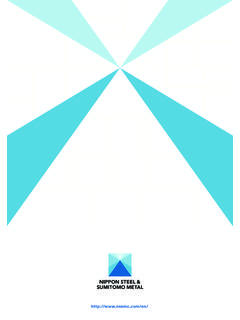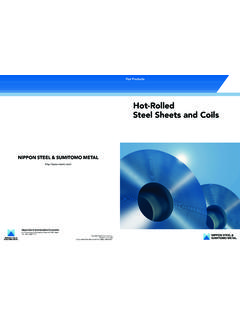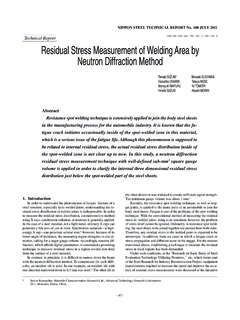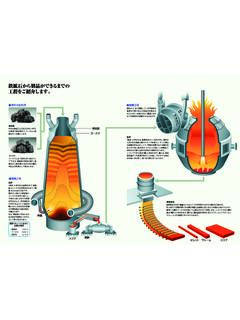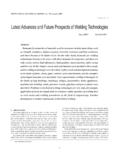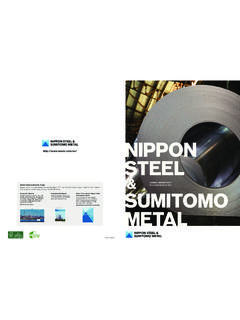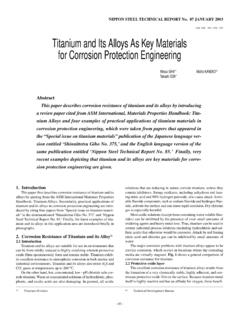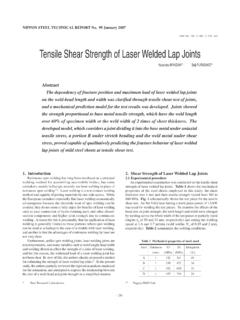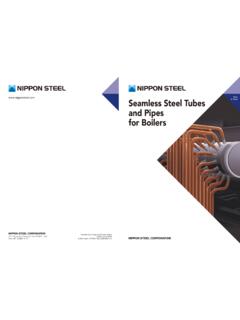Transcription of Technical Report Dissimilar Metal Joining …
1 NIPPON STEEL Technical Report No. 103 MAY 2013-91-1. IntroductionToday, measures to curb global warming are being employed in diverse fields such as energy, ships, aircrafts, rail rolling stocks, au-tomobiles, and household appliances. The automotive industry, too, has been making positive efforts to reduce CO2 gas emissions through reduction of the weight of car )The most striking of these efforts is the application of high-strength steel sheets (590 to 1,470 MPa) to automotive ) Considerable volumes of high-strength steel sheet have already been applied to not only reduce the weight of car bodies but also enhance their crashworthiness. It is expected that efforts to further reduce car body weight by making most effective use of high-strength steel sheet will be continued in the future. However, considering the stiff-ness required of each member, there is a certain limit to the reduc-tion of weight through the use of thinner steel sheets.
2 If a further weight reduction of 30% or more is called for in the future, it will become necessary to develop and deploy a multi-material structure composed partly of lightweight )Materials such as aluminum alloy, magnesium alloy, plastics, Technical Report UDC 621 . 791 / . 792 : 621 . 88 : 669 . 14 - 415 : 669 . 715 : 629 . 11 . 011 . 5* Senior Researcher, Welding & Joining Research Center, Steel Research Laboratories 20-1 Shintomi, Futtsu, Chiba 293-8511 Dissimilar Metal Joining Technologies for Steel Sheet and Aluminum Alloy Sheet in Auto BodyTatsuya SAKIYAMA* Gen MURAYAMAY asuaki NAITO Kenji SAITAY asunobu MIYAZAKI Hatsuhiko OIKAWAT etsuro NOSEA bstractMulti-material structure of auto body partially employing aluminum alloy sheets may be adopted in order to satisfy requests at the same time improving crash safety and lightweight. This paper described the Dissimilar Metal Joining technologies required to achieve multi-material structure.
3 In resistance spot welding, high current & short time welding condition is conducted to avoid formation of brittle Fe-Al intermetallic compound layer at joint inter-face and joint strength is investigated. In mechanical Joining , current application situation of SPR, Tog-L-Loc , TOX and FDS methods are outlined and application examples of Blind rivet in automobile body are introduced. In addition to that, joint strengths in shear direction of SPR joints for cold rolled steel sheets and 6000 series aluminum alloy sheets are described. In adhesion bonding, it was shown that joint strength of TSS over 20 MPa is obtained by using of recent adhesive for automobile in sheet combinations of cold rolled mild steel sheets and 6000 series aluminum alloy sheets. In FSSW, effects of holding time, rotating speed and coating layer on joint strength were clarified in sheet combinations of Super Dyma steel sheets and 6000 series aluminum alloy sheets.
4 Also, in laser brazing, it was shown that Joining of cold rolled or GA mild steel sheets and 6000 series aluminum alloy sheets are possible by using 4000 series aluminum alloy filler (A4043) with fluoride type NOCOLOK flux. Finally, direction of development needed in the future in the field of Dissimilar Metal Joining technologies of steel and aluminum alloy was described based on past development STEEL Technical Report No. 103 MAY 2013-92-and carbon-fiber-reinforced plastic allow for reduction of car body weight,3) among which aluminum alloy seems the most promising on the basis of actual use to date and cost. However, in light of the costs and properties of aluminum alloy as a structural material, the most effective way of using aluminum alloy is applying it only where really needed. For this reason, aluminum alloy has so far been applied to only those car body parts that do not require ex-tremely high strength, such as the hood, trunk, doors, and ) Such partial application of aluminum alloy calls for technology to join aluminum alloy sheet and steel sheet, which exhibit different material methods have been proposed to join materials together, including fusion welding ( , resistance spot welding, resistance seam welding, arc welding), solid state bonding ( , explosive welding, friction welding, electromagnetic welding, roll bonding, diffusion bonding), brazing ( , burner brazing, arc brazing, laser brazing), mechanical Joining ( , self-pierce riveting (SPR), TOX , flow drill screw (FDS ), blind riveting), and adhesive ) In addition, Joining methods using coating or inserts have been )
5 For any Joining method that requires high temperatures, a brit-tle layer of intermetallic compound (IMC) is formed at the joint in-terface, making it difficult to obtain the desired joint strength. In practice, therefore, attention was first paid to mechanical methods that do not form this unwanted layer of two Dissimilar metals come into contact, the difference in their ionization tendency causes corrosion to occur at the interface. To prevent this, attempts have been made to use mechanical Joining and adhesive bonding in ) Such methods have been put into practical use ahead of other Joining methods and are still used ) It is also possible to restrain the formation of a brittle layer of IMC by applying solid state bonding. Therefore, friction welding and friction stir spot welding (FSSW) have been put into use for propeller shafts 11) and hatchback doors,12) respectively.
6 Thus, various methods have been developed for Joining steel sheet and aluminum alloy sheet, a process that was previously considered dif-ficult. With the recent strong demand for lighter car bodies, the need for such Joining methods is again increasing. Spot welding, mechan-ical Joining , adhesive bonding, FSSW, and laser brazing are consid-ered to be especially promising technologies for Joining steel and aluminum alloy sheets; therefore, we describe here the research into these materials and their application to actual cars in recent Spot WeldingWhen steel sheet and aluminum alloy sheet are spot welded, the very brittle IMC produced at the interface during welding becomes a ) The presence of this material can decrease joint strength, especially the cross -tension strength (CTS). Therefore, for today s car bodies, a Joining method that combines mechanical join-ing ( , SPR, TOX , etc.
7 And adhesive bonding is most widely ) In this section, the weldability and joint strength of spot welding are examined by the combination of a gal-vannealed (GA) mild steel sheet and a 6000-series aluminum alloy welding machine used was a pneumatic, single-phase, recti-fier-type welder (power frequency: 50 Hz) with a rated capacity of 150 kVA, and the electrode used was a chromium-copper electrode of Dome Radius (DR) type with a tip diameter of 8 mm. The weld-ing conditions were as follows: squeeze time, 70 cycles; upslope time, 2 cycles; weld time, 3 cycles; hold time, 20 cycles; and elec-trode force, 1 illustrates the relationship between welding current and CTS. In the welding current range, the average value of CTS was about kN/spot. Any welding current lower than the welding cur-rent range resulted in an unwelded condition, while any welding current higher than the welding current range caused the aluminum alloy sheet and the electrode to fuse.
8 The welding current range was less than kA and the fracture mode in this range was always a plug fracture at the aluminum alloy sheet side. Fig. 2 shows the de-pendence of CTS on plug diameter of spot weld, obtained by a cross -tension test. Thus, the correlation between plug diameter and CTS is can be expressed by the following ) CTS = B . t . ( . FDc) . TS . sin (1)where B denotes a coefficient, t is sheet thickness, FDc plug diame-ter, TS base Metal tensile strength, and the base Metal deformation angle right before fracture. Specifically, t is the sheet thickness (plug thickness) at the fractured part. Fig. 3 shows a macroscopic view of Fig. 1 Dependence of cross tension strength on welding currentFig. 2 Dependence of cross tension strength on plug diameterFig. 3 Macro cross section of spot weld after cross tension test (welding current )NIPPON STEEL Technical Report No.
9 103 MAY 2013-93-the cross section of a weld subjected to a cross tension test. It can be seen that the plug thickness is about 25% of the thickness of the base Metal of the aluminum alloy sheet. Thus, in spot welding of steel sheet and aluminum alloy sheet, the decrease in aluminum al-loy sheet thickness is so large that the joint strength cannot be ex-pressed by the plug diameter alone. Thus, it is necessary to consider the plug thickness Mechanical Trends of mechanical Joining methodsVarious methods exist for mechanical ) In the field of automobiles (in addition to conventional Joining methods such as using nuts, bolts, and screws), new methods such as SPR, Blind Rivet, TOX , Tog-L-Loc , and FDS have come to be applied in re-cent , 16-19). Mechanical Joining provides joints of high quality and allows for automatic operation. Because of these advantages, study of the application of SPR and TOX began early,20-23) and these methods came to be applied to high-grade cars ahead of other new Joining offers strong joints but can cause significant damage to the material surface.
10 Therefore, it is applied mainly to parts that demand strong joints. Blind riveting permits access to the material from one side, causes little damage to the material, and offers strong joints. Thus, both SPR and blind riveting result in joints with high strength. However, the rivets used are relatively expensive. Furthermore, the latter method requires previous drilling of the materials to be and Tog-L-Loc clinch two materials together by pressing them with a punch and ) These techniques result in very little damage to the material surface, although the joints obtained are not very strong. Therefore, they are applied to parts that demand good appearance and corrosion resistance. FDS , which was proposed only recently, is a method in which a screw turning at high speed is pushed into the material and fused with the base Metal by the resultant frictional ) Fig. 4 (a) illustrates a macroscopic view of the cross section of a joint between GA mild steel sheet and 6000-series aluminum alloy sheet obtained by Tog-L-Loc ; Fig.
